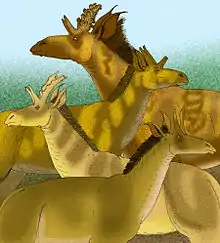Ossicone
Ossicones are paired horn-like or antler-like weapons on the heads of some even-toed ungulates in the superfamily Giraffoidea, distinguished by their unique development and a permanent covering of skin and fur. More precisely, ossicones are present in some members of the family Giraffidae (including giraffes, male okapi, and their extinct relatives) and the closely related, extinct family Climacoceratidae.[1] It has been argued that the so-called ossicones known from fossils are actually horns; however, later research has revealed their protuberances to be consistent with the ossicones of giraffes and okapi.[2]

_2009-04-04_01.jpg.webp)

Structure
Ossicones are present at birth, located dorsally of the frontal bone. Initially, they are capable of being retroflexed and are not attached to the skull, which permits successful descent of the birth canal. Ossicones fuse to the skull later in life.[3]
Ossicones are similar to the horns of antelopes and cattle, except that they are derived from ossified cartilage[4] or subcutaneous connective tissues rather than living bone,[5] and that the ossicones remain covered in skin and fur, rather than horny keratin. Antlers (as on deer) are derived from bone tissue: when mature, the skin and fur covering of the antlers, termed "velvet", is, unlike ossicones, sloughed and scraped off to expose the bone of the antlers.
In giraffes, male and female ossicones vary in structure and purpose (a manifestation of sexual dimorphism). Males typically have thicker ossicones that become bald on top due to frequent necking.[6] In okapi, the male's ossicones are smaller in proportion to the head, and taper towards their tips, forming a sharper point than the comparatively blunt giraffe ossicone. Whereas female giraffes have reduced ossicones, female okapi lack ossicones entirely.
Function
Similar to species that possess horns or antlers, giraffids use their ossicones as a weapon by necking and concentrating the force of impact onto a small area. Ossicones add weight to the animal's head, allowing it to deliver heavier, sometimes fatal, blows. The added weight is an evolutionary trait bred from necessity. The addition of ossicones also leads to other evolutionary adaptations such as heavy hides and specialized dermal shields for defence.[6]
References
- Hadar Picture Gallery. An ossicone of the extinct, giant, short-necked giraffe. University of Washington.
- Solounias, N (1988). "Prevalence of Ossicones in Giraffidae (Artiodactyla, Mammalia)". Journal of Mammalogy. 69 (4): 845–8. doi:10.2307/1381645. JSTOR 1381645.
- "FAQs - GiraffeConservation.org". GiraffeConservation.org. Retrieved 2018-04-26.
- "The Nashville Zoo at Grassmere – Animals :: Masai Giraffe". Nashville Zoo at Grassmere. 30 Jun 2008. Archived from the original on 2008-06-30.
- Nasoori, Alireza (2020). "Formation, structure, and function of extra-skeletal bones in mammals". Biological Reviews. 95 (4): 986–1019. doi:10.1111/brv.12597. PMID 32338826. S2CID 216556342.
- Geist, Valerius (1966). "The Evolution of Horn-Like Organs". Behaviour. 27 (1): 175–214. doi:10.1163/156853966x00155.
Further reading
- Hou, Sukuan; Danowitz, Melinda; Sammis, John; Solounias, Nikos (2014). "Dead ossicones, and other characters describing Palaeotraginae (Giraffidae; Mammalia) based on new material from Gansu, Central China". Zitteliana. 32: 91–8.
- Solounias, N; Moelleken, S. M. C (1991). "Evidence for the Presence of Ossicones in Giraffokeryx punjabiensis (Giraffidae, Mammalia)". Journal of Mammalogy. 72 (1): 215–7. doi:10.2307/1382004. JSTOR 1382004.
- Churcher, Charles S (1990). "Cranial Appendages of Giraffoidea". Horns, Pronghorns, and Antlers. pp. 180–94. doi:10.1007/978-1-4613-8966-8_5. ISBN 978-1-4613-8968-2.
- Davis, E. B; Brakora, K. A; Lee, A. H (2011). "Evolution of ruminant headgear: A review". Proceedings of the Royal Society B: Biological Sciences. 278 (1720): 2857–65. doi:10.1098/rspb.2011.0938. JSTOR 41315010. PMC 3151718. PMID 21733893. Lay summary – ScienceDaily (July 10, 2010).
- Danowitz, Melinda; Barry, John C; Solounias, Nikos (2017). "The earliest ossicone and post-cranial record of Giraffa". PLOS ONE. 12 (9): e0185139. doi:10.1371/journal.pone.0185139. PMC 5605118. PMID 28926638.
- Ríos, María; Sánchez, Israel M; Morales, Jorge (2017). "A new giraffid (Mammalia, Ruminantia, Pecora) from the late Miocene of Spain, and the evolution of the sivathere-samothere lineage". PLOS ONE. 12 (11): e0185378. doi:10.1371/journal.pone.0185378. PMC 5665556. PMID 29091914. Lay summary – Science (November 2, 2017).
